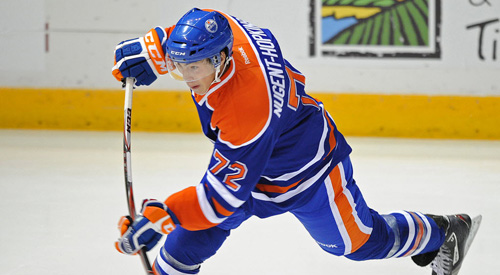
The Kids are Alright
While training resources and skill development programs are only continuing to evolve, hockey fans are growing accustomed to seeing top-rated prospects enter the NHL at a much younger age, many of whom have an immediate impact on their respective teams.
Whether it’s been the more hyped-up players like Jonathan Toews, Steven Stamkos, John Tavares or Taylor Hall, or the under-the-radar surprises such as Jeff Skinner, Logan Couture, Jordan Eberle and Jamie Benn, the league’s young guns seem to be taking over the headlines more and more with each new season, and 2011-12 has been no exception.
Highlighted by Ryan Nugent-Hopkins’ killer start to the season and the stellar play of Devils’ power forward Adam Henrique, both the rookie and sophomore classes have quite a collection of talent and value that team’s have made no mistake in putting to use – and it’s not just the players who can put up numbers, either.
A new breed of responsible, yet often overshadowed crash-and-bang forwards have surfaced over the past few seasons, and it’s this type of player that teams are starting to gun for in the mid-to-late rounds.
Take Los Angeles Kings’ sophomore 21-year-old Kyle Clifford, whose well-rounded game consists of penalty killing, third- and fourth-line minute munching, hitting and dropping the gloves when need be. He earned himself a roster spot last season ahead of the highly-touted and then-King Brayden Schenn, and it’s because of Clifford’s ability to fill essentially any role required of him that he immediately became a key part of L.A.’s depth in the regular and post-season.
[php snippet=1]
This year, similar players in Philadelphia Flyers rookie Zac Rinaldo and recent Chicago Blackhawks addition Andrew Shaw who have also become integral pieces to their playoff-bound clubs.
In 40 games thus far, the 21-year-old Rinaldo has racked up seven points and 156 penalty minutes, and although his average ice time is just 6:37 per game, Rinaldo can be counted upon to step in when his team faces a mid-game injury or simply needs an extra spark.
As for the 20-year-old Shaw, who joined the Blackhawks midway through the season after having a successful start to his pro campaign in Rockford, his five goals and eight points in just 17 games have him ranked 31st among rookies in points, going into Tuesday night. Coincidentally, Shaw’s first NHL fight came in his first NHL game, where he squared off with Rinaldo at center ice.
In addition to the physical youngsters comes a group of successful two-way players who have also turned heads after making their league debuts this season.
Cody Hodgson, Sean Couturier, Luke Adam and Ryan Johansen have all become NHL regulars, and certainly take on a hefty workload despite being so young.
While those players are in the top-12 among rookie scorers and are having success contributing both offensively and defensively (Hodgson leading the group with 15 goals, 31 points and a +8 rating as of Tuesday night), there are several others who could fit that category but haven’t yet had quite the start numbers wise.
Washington’s Cody Eakin has played impressively for the Capitals in 29 games, contributing eight points while remaining a plus player – similar to Tampa’s Brett Connolly and Anaheim’s injured Devante Smith-Pelly, who have also made a name for themselves by playing a balanced and defensively-responsible game.
Although it’s a more difficult task to break into the NHL as a young defenseman, Toronto’s Jake Gardiner, Ottawa’s Jared Cowan, and more recently, Nashville’s Ryan Ellis, have all done so successfully this season as well.
Gardiner and Cowan have had no trouble putting up points, as the pair are both in the top-20 in rookie scoring, while Ellis joined the Preds in late December, and has since scored three goals – two on the power play – and six assists with a plus-eight rating, thanks to two-point night that included the game-winning goal Tuesday against Chicago.
Taking all into consideration, you have to wonder what factors may contribute to the recent spike in 21-and-under talent that seems to be lining rosters throughout the NHL.
My theory? It’s because of the new direction the game is taking coupled with the increased knowledge and tools these athletes are exposed to at a young age.
Instead of signing or calling up veteran minor leaguers, or inserting “enforcers” into the lineup here and there (which, granted, still does occur), teams are finding ways to test out young talent that can contribute in all areas of the game.
It’s no secret that fighting, or at least the roll of the “goon” is being fazed out of the sport, so scouts and minor league coaches are making sure players coming up have the ability to contribute in multiple ways.
Because of the enhanced training and development resources these players have access to, teams may be finding they are more physically ready; prepared to compete at a younger age, and able to fill many different roles, which is a greater benefit to a team’s depth than dressing a one-dimensional player whose career is winding down.
As an alternative to building third and fourth lines with “rental” players or call-ups, it simply makes more sense to give the youngsters a taste of the NHL and have them learning from the veteran mainstays.
[php snippet=1]

